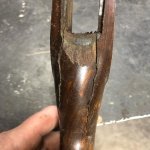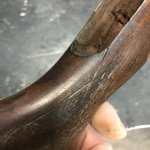1) Boil the kettle full of water
2) In a big Brown Betty teapot, place 3 tea bags (yes orange pekoe [which is actually black tea] will work, so will Tetley's &c., but NOT the new Red Rose, which has raw green tea added - the "brainiac" who came up with that idea and ruined Red Rose was probably the same moron who moved production from St. John's to some overseas $#!T-hole)
3) Now let the tea "steep" for a day or so, so that most of the tannins are released from the bags to the tea
4) Take a heavy piece of bond paper (type-writer or copy paper) which you have cut up into strips [I do 1/2", 1" & 2" strips, each about 2" long [you're going to get a fair bunch from an 8 1/2" x 11" letter sized piece of paper so you'll have left-overs to use in repairing the next split stock
5) place in container with the cold steeped tea [if you use your tea-pot, how are you going to make a cuppa?]
6) Let sit 2 or 3 days
7) Take out the "coloured" paper & let dry [probably at least a day] on some old newspaper, preferably weighted down so they don't get all crinkly which then impairs your ability to work the paper into the crack
8) Now you have your "grain" paper.
Once you have de-greased the stock and have "eased" it apart, first syringe in the epoxy of your choice into the crack [you do NOT want to use quick-set epoxy for this], then insert the paper into the crack [I use a sawing motion to work it down into the crack, leaving an 1/8" or so of the paper proud of the wood. [You may want to do a trial run on a piece of lumber that you have purposely cracked to give you a feel for it] I've tried inserting the paper first but found the epoxy then went on only 1 side of the paper; YMMV
Once dry, use a brand-new thin Exacto knife blade [by itself, not inserted into the holder; be careful, they're sharp] to cut the extra from the stock, then sand down. Because of the darkened paper sandwiched between epoxy layers, it will give the appearance of grain, rather than what it is.
Sorry if my explanation is NFG.










































































